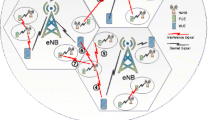Abstract
This paper discusses downlink inner loop power control of dedicated channels in UTRA TDD. The current UTRA TDD downlink power control is similar to one in UTRA FDD mode, that comprises of closed inner loop and quality based outer loop. However, due to the time division feature and associated fexibility with asymmetry of TDD, the inner loop can not react as fast as in FDD and it is affected by rapid changes in environment. Therefore, the effect of the inner loop algorithm to the performance of UTRA TDD network is studied in this paper. Especially, the use of asymmetric step sizes for “power up” and “power down” commands is evaluated in contrast to the conventional symmetric power adjustment. Since it would be beneficial for the downlink inner loop power control to reach the target SIR as fast as possible, the power control step size based on the difference between the UE measured SIR and target SIR would be the most desirable power adjustment. Since the effectiveness of this type of an algorithm depends on available signaling bandwidth that is used, a study is carried out to find the tradeoff between the signaling bandwidth and related network performance.
Similar content being viewed by others
References
http://www.3gpp.org, 2002.
H. Holma and A. Toskala (eds.), WCDMA for UMTS, Wiley, New York, 2000.
J. Kurjenniemi, S. Hamalainen and T. Ristaniemi, “Handover and Uplink Power Control Performance in the 3.84 Mcps TDD Mode of UTRA Network”, Wireless Personal Communications, Vol. 27, No. 4, pp. 337–351, December 2003.
J. Kurjenniemi, O. Lehtinen and T. Ristaniemi, “Downlink Power Control of Dedicated Channels in UTRA TDD”, in Proceedings of IEEE Symposium on Personal, Indoor and Mobile Radio Communications (PIMRC), Lisbon, Portugal, September 15–18, 2002, CD-ROM.
S.-H. Shin, C.-S. Koo, D. Grieco and A. Zeira, “Pathloss-Aided Closed Loop Transmit Power Control for 3G UTRA TDD”, in Proceedings of IEEE Vehicular Technology Conference (VTC 2003-Spring), Jeju, Korea, Vol. 4, pp. 2226–2230, April 21–24, 2003.
A. Sampath, P. Sarath Kumar and J.M. Holtzman, “On Setting Reverse Link Target SIR in a CDMA System”, in Proceedings of IEEE 47th Vehicular Technology Conference, pp. 929–933, 4–7 May, 1997.
3rd Generation Partnership Project, Technical Specification Group, Radio Access Network, Working Group 4, UTRA (UE) TDD; Radio Transmission and Reception, TS25.102 v4.0.0, 2001.
3rd Generation Partnership Project, Technical Specification Group, Radio Access Network, Working Group 4, UTRA (BS) TDD; Radio Transmission and Reception, TS25.105 v4.0.0, 2001.
3rd Generation Partnership Project, Technical Specification Group, Radio Access Network, Working Group 4, Requirements for Support of RRM, TS25.123 v4.0.0, 2001.
3rd Generation Partnership Project, Technical Specification Group, Radio Access Network, Working Group 1, Physical Channels and mapping of transport channels onto physical channels (TDD), TS25.221 v4.0.0, 2001.
3rd Generation Partnership Project, Technical Specification Group, Radio Access Network, Working Group~1, Spreading and modulation (TDD), TS25.223 v4.0.0, 2001.
3rd Generation Partnership Project, Technical Specification Group, Radio Access Network, Working Group~1, Physical Layer procedures (TDD), TS25.224 v4.0.0, 2001.
3rd Generation Partnership Project, Technical Specification Group, Radio Access Network, Working Group~1, Physical Layer – Measurements, TS25.225 v4.0.0, 2001.
3rd Generation Partnership Project, Technical Specification Group, Radio Access Network, Working Group~4, TDD base station classification, TS25.952 v4.0.0, 2001.
Universal Mobile Telecommunications System (UMTS), Selection procedures for the choice of radio transmission technologies of the UMTS, TR101.112 v3.2.0, UMTS30.03, April 1998.
Author information
Authors and Affiliations
Corresponding author
Additional information
Janne Kurjenniemi was born in Jyväskylä, Finland, in March 1974. He received the M.Sc. in telecommunications in 2001 from the University of Jyväskylä, Jyväskyl, Finland. He is working as a Researcher at the Department of Mathematical Information Technology, University of Jyväskylä. His research interests include radio resource management for wireless communication systems.
Otto-Aleksanteri Lehtinen was born in Tampere, Finland, in September 1971. He received the Master of Science in Technology in 1999 from the Helsinki University of Technology, Department of Electrical engineering (major in radio technology, minor signal processing and computer devices). His research interests include radio resource management for wireless communication systems.
Tapani Ristaniemi was born in Kauhava, Finland, in 1971. He received the M.Sc. in mathematics in 1995, Ph.Lic. in applied mathematics in 1997, and Ph.D. in telecommunications in 2000 from the University of Jyväskylä, Jyväskylä, Finland. During 2001–2003 he was a professor of telecommunications at the Department of Mathematical Information Technology, University of Jyväskylä. In 2003 he joined the Institute of Communications Engineering in the Tampere University of Technology, Finland, where he has been a professor of wireless data communications. His research interests include signal processing for communications and radio resource management for wireless networks.
Rights and permissions
About this article
Cite this article
Kurjenniemi, J., Lehtinen, O. & Ristaniemi, T. Signaled Step Size for Downlink Power Control of Dedicated Channels in UTRA TDD. Wireless Pers Commun 31, 161–180 (2004). https://doi.org/10.1007/s11277-004-3855-1
Issue Date:
DOI: https://doi.org/10.1007/s11277-004-3855-1




